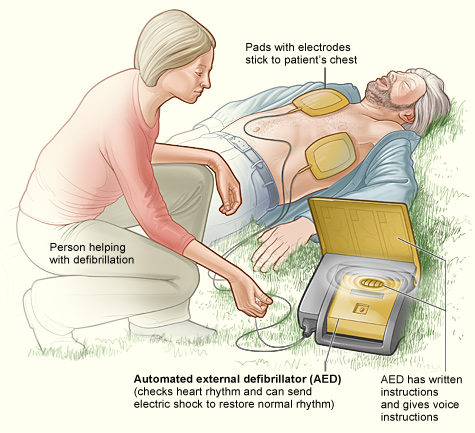Before using an automated external defibrillator (AED) on someone who you think is having sudden cardiac arrest (SCA), check him or her.
If you see a person suddenly collapse and pass out, or if you find a person already unconscious, confirm that the person can’t respond. Shout at and shake the person to make sure he or she isn’t sleeping.
Never shake an infant or young child. Instead, you can pinch the child to try to wake him or her up.
Call 9–1–1 or have someone else call 9–1–1. If two rescuers are present, one can provide CPR (cardiopulmonary resuscitation) while the other calls 9–1–1 and gets the AED.
Check the person’s breathing and pulse. If breathing and pulse are absent or irregular, prepare to use the AED as soon as possible. (SCA causes death if it’s not treated within minutes.)
If no one knows how long the person has been unconscious, or if an AED isn’t readily available, do 2 minutes of CPR. Then use the AED (if you have one) to check the person.
After you use the AED, or if you don’t have an AED, give CPR until emergency medical help arrives or until the person begins to move. Try to limit pauses in CPR.
After 2 minutes of CPR, you can use the AED again to check the person’s heart rhythm and give another shock, if needed. If a shock isn’t needed, continue CPR.
Using an Automated External Defibrillator
AEDs are user-friendly devices that untrained bystanders can use to save the life of someone having SCA.
Before using an AED, check for puddles or water near the person who is unconscious. Move him or her to a dry area, and stay away from wetness when delivering shocks (water conducts electricity).
Turn on the AED’s power. The device will give you step-by-step instructions. You’ll hear voice prompts and see prompts on a screen.
Expose the person’s chest. If the person’s chest is wet, dry it. AEDs have sticky pads with sensors called electrodes. Apply the pads to the person’s chest as pictured on the AED’s instructions.
Place one pad on the right center of the person’s chest above the nipple. Place the other pad slightly below the other nipple and to the left of the ribcage.
Make sure the sticky pads have good connection with the skin. If the connection isn’t good, the machine may repeat the phrase “check electrodes.”
If the person has a lot of chest hair, you may have to trim it. (AEDs usually come with a kit that includes scissors and/or a razor.) If the person is wearing a medication patch that’s in the way, remove it and clean the medicine from the skin before applying the sticky pads.
Remove metal necklaces and underwire bras. The metal may conduct electricity and cause burns. You can cut the center of the bra and pull it away from the skin.
Check the person for implanted medical devices, such as a pacemaker or implantable cardioverter defibrillator. (The outline of these devices is visible under the skin on the chest or abdomen, and the person may be wearing a medical alert bracelet.) Also check for body piercings.
Move the defibrillator pads at least 1 inch away from implanted devices or piercings so the electric current can flow freely between the pads.
Check that the wires from the electrodes are connected to the AED. Make sure no one is touching the person, and then press the AED’s “analyze” button. Stay clear while the machine checks the person’s heart rhythm.
If a shock is needed, the AED will let you know when to deliver it. Stand clear of the person and make sure others are clear before you push the AED’s “shock” button.
Start or resume CPR until emergency medical help arrives or until the person begins to move. Stay with the person until medical help arrives, and report all of the information you know about what has happened.
We also offer a free certificate of completion. To receive the certificate you must pass a 50-question test with a score of 70 or higher. Check our Basic First Aid Certificate of Completion page for more information.
